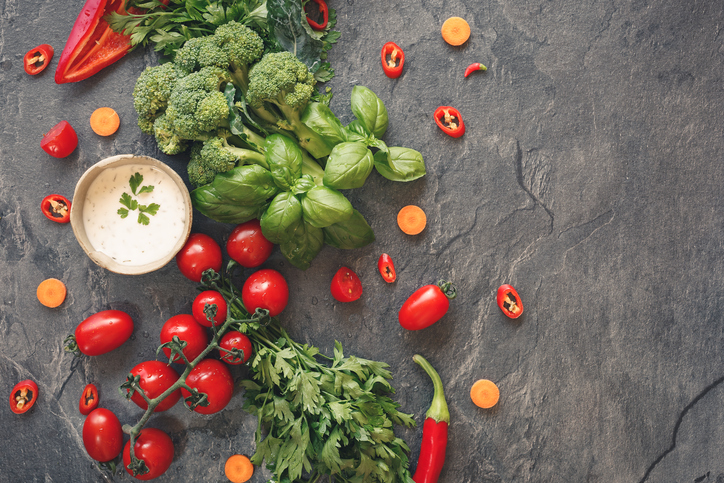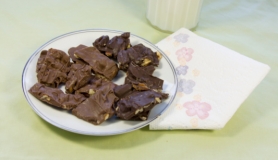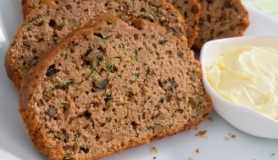My family is one of the greatest joys of my life and nourishing them with delicious, nutritious food is a true pleasure and a responsibility I don’t take lightly. The eating habits we teach our kids, starting from when they first begin exploring solids through to their teenage years stay with them for life. It’s so important that we help to set them on the right path and show them how to make healthy choices for themselves. My daughters Chilli and Indii often help in the kitchen and always set the table, then we all sit down together and enjoy food and conversation. I believe the best way to eat well and feel good is the paleo way: applying Palaeolithic principles to the way we eat. This means packing our diet with what our preagricultural ancestors ate – these are the foods that our bodies are best adapted to. In a nutshell its about minimising consumption of sugary and starchy foods, moderating protein intake, eating as much good-quality, unprocessed fats as you need to support a healthy nervous system and increasing consumption of fibrous veggies. It’s a simple style of eating that accentuates real food. Here are some straightforward, affordable and most importantly- downright yummy recipes to get you started:
kid-friendly kimchi
My daughter Indii loves spicy food, whereas her older sister, Chilli, can’t stand anything spicy (I think we got their names around the wrong way!). Kimchi is a kick-ass dish, full of bioavailable nutrients. It makes a welcome addition to any Asian meal, or simply pop it on some fried or scrambled eggs for the best brekkie of your life. With fermented vegetables, always keep in mind that if you heat them, you start killing off the good bacteria. It is always preferable to eat them chilled or at room temperature. • 400g red cabbage • 400g green or white cabbage • 100 g mooli (white radish), diced • 1 green apple, cored and julienned • 1 red onion, thinly sliced • 1 French shallot, thinly sliced • 1 handful of coriander leaves, chopped • juice of 1 lemon • 1½ teaspoons sea salt • 1 sachet vegetable starter culture* (this will weigh 2–5g, depending on the brand)
1. You will need a 1.5 litre preserving jar with an airlock lid for this recipe. Wash the jar and all the utensils you will be using in very hot water. Dry well and set aside. Alternatively, run them through a hot rinse cycle in the dishwasher.
2. Remove the outer leaves of the cabbages. Choose an unblemished leaf, wash it well and set aside for later. Shred the cabbages in a food processor or slice with a knife or mandoline, then transfer to a large glass or stainless steel bowl. Add the mooli, apple, onion, shallot, coriander, lemon juice and salt and mix well. Cover and set aside.
3. Prepare the starter culture according to the directions on the packet. Add to the vegetables and mix thoroughly.
4. Using a large spoon, fill the prepared jar with the vegetable mixture, pressing down well to remove any air pockets and leaving 2 cm of room at the top. The vegetables should be completely submerged in the liquid. Add more water, if necessary.
5. Take the clean cabbage leaf, fold it up and place it on top of the mixture, then add a small glass weight (a shot glass is ideal) to keep everything submerged. Close the lid, then wrap a tea towel around the side of the jar to block out the light.
6. Store the jar in a dark place with a temperature of 16–23°C for 10–14 days. Different vegetables have different culturing times and the warmer it is the shorter the time needed. The longer you leave it, the higher the level of good bacteria and the tangier the flavour. 7. Chill before eating. Once opened, the kimchi will last for up to 2 months in the fridge when kept submerged in liquid. If unopened, it will keep for up to 9 months in the fridge.
MAKES 1 × 1.5 LITRE JAR
courgette chips with herb aioli
This is a ripper of a recipe and it’s guaranteed to get your kids wolfing down courgettes like there’s no tomorrow. The best way to get kids to try new foods is to get them into the kitchen to help with the preparation – they want to see and taste their handiwork. Being able to pick some courgettes from your garden or a friend’s garden would really seal the deal! The spiced seasoning adds a lovely kick to these – just go easy on it if your kids aren’t into spice.
1 egg • 125 ml (½ cup) almond milk • 50 g (½ cup) arrowroot • 100 g (1 cup) ground almonds • 2 large courgettes, cut into 7.5cm batons, about 1 cm thick • 300 ml refined or unscented coconut oil
HERB AIOLI • 1 tablespoon finely chopped flat-leaf parsley leaves • ½ teaspoon finely grated lemon zest • 250 g aioli
SPICED SEASONING • 3 tablespoons sea salt • 2 tablespoons paprika • 1 tablespoon garlic powder • 1 teaspoon ground cumin • 1 teaspoon ground white pepper • ½ teaspoon chilli powder • ½ teaspoon celery salt
1. To make the spiced seasoning, combine all the ingredients in a small bowl and stir well. Set aside until ready to use.
2. To make the herb aioli, place ingredients in a bowl and mix well. Refrigerate until required.
3. Whisk the egg with the almond milk until combined.
4. Place the arrowroot and ground almonds into two small, shallow bowls.
5. Individually coat each courgette stick in the arrowroot, shaking off any excess. Dip the coated courgette in the egg mixture then roll in the ground almonds, ensuring it is coated evenly. If you miss some patches, simply dab a little more egg mixture onto the dry areas and coat again with the ground almonds.
6. Heat the coconut oil in a large, deep frying pan over medium heat. Test if the oil is hot enough by dropping in a small piece of courgette – if the oil begins to bubble around the courgette, it has reached the ideal temperature. Add the courgette chips in batches, and cook for 2 minutes on each side, or until golden brown and crisp. Remove the chips from the pan using metal tongs or a slotted spoon, and transfer to paper towel to drain. Allow the chips to cool slightly before serving.
7. Sprinkle with a little spiced seasoning and serve with herb aioli. The leftover spiced seasoning can be stored in an airtight container in the pantry for several months.
SERVES 4
margherita pizza
Tomato and basil have got to be among the greatest flavour combinations of all time. Just ask the Italians, who use them in so many dishes, including caprese salad, spaghetti and meatballs and the most famous of all – the margherita pizza (named in honour of Queen Margherita in 1889 by a local Italian pizza maker). Here, I have replaced the buffalo mozzarella with cashew cheese to make it dairy free, but the rest is the same – tomato, basil and a crispy base to carry these amazing flavours.
• 4 tablespoons Pizza Sauce* • 2 tablespoons chopped flat-leaf parsley leaves • 6 cherry tomatoes, sliced • 100 g Cashew Cheese** • sea salt and freshly ground black pepper • 8 basil leaves, to serve • 2 macadamia nuts, grated, to serve • extra-virgin olive oil, to serve
PALEO PIZZA BASE • 260 g (2½ cups) ground almonds • 130 g (1 cup) arrowroot or tapioca flour • 1½ teaspoons baking powder • 1 teaspoon sea salt • 3 eggs • 4 tablespoons coconut oil, melted • 125 ml (½ cup) nut milk
1. To make the paleo pizza base, preheat the oven to 180°C (gas 4). Line a large baking tray with baking paper.
2. Combine the ground almonds, arrowroot or tapioca flour, baking powder and salt in a large bowl. In a separate bowl, whisk together the eggs, oil and nut milk.
3. Fold the egg mixture into the dry ingredients, one-third at a time, and mix thoroughly to form a smooth, thick dough.
4. Spoon the dough onto the prepared tray. Using a palette knife or spatula, spread the dough out in a round or rectangular shape to a thickness of 5 mm. You can make the pizza bases as big or small as you like depending on who it is for (kids usually love to have their own individual pizzas!). This amount of dough will make two 30 cm round pizza bases. Bake for 5 minutes until the pizza base is cooked through and lightly browned. Remove from the oven and set aside to cool.
5. Increase the oven to 240°C (gas 9) or as high as it will go.
6. Flip the pizza base andevenly spread over the pizza sauce. Scatter on the parsley and cherry tomato slices and dollop the cashew cheese on top. Season with salt and pepper. Return to the oven and cook for a further 5–10 minutes, or until golden and crisp.
7. Remove from the oven, cut into portions and garnish with the basil leaves, grated macadamias and a drizzle of olive oil. SERVES 4
TO MAKE THE PIZZA SAUCE • 1 × 400 g can whole peeled tomatoes • ¼ teaspoon Himalayan salt or sea salt • 1 teaspoon dried oregano • 2 pinches of freshly ground black pepper
Combine all the ingredients in a food processor and process until smooth.
**TO MAKE THE CASHEW CHEESE • 320 g cashews or macadamia nuts • 1–1½ tablespoons lemon juice • 1 teaspoon sea salt • pinch of freshly ground black pepper 1. Soak the cashews or macadamias in 750 ml of water for 6 hours. Drain and rinse well. 2. Place the nuts in a food processor with the lemon juice, salt and pepper and pulse for 1 minute to combine. Add 120 ml of water and continue to process until smooth. If the cheese seems overly thick or dry, gradually add more water and lemon juice to adjust the consistency. You may need to add more water if using macadamia nuts instead of cashews. The nut cheese can be stored in an airtight container in the fridge for up to 1 week. MAKES 600 G
MORE INSPIRATION
READ Family Food by Pete Evans (published in trade paperback by Macmillan, £18.99).







